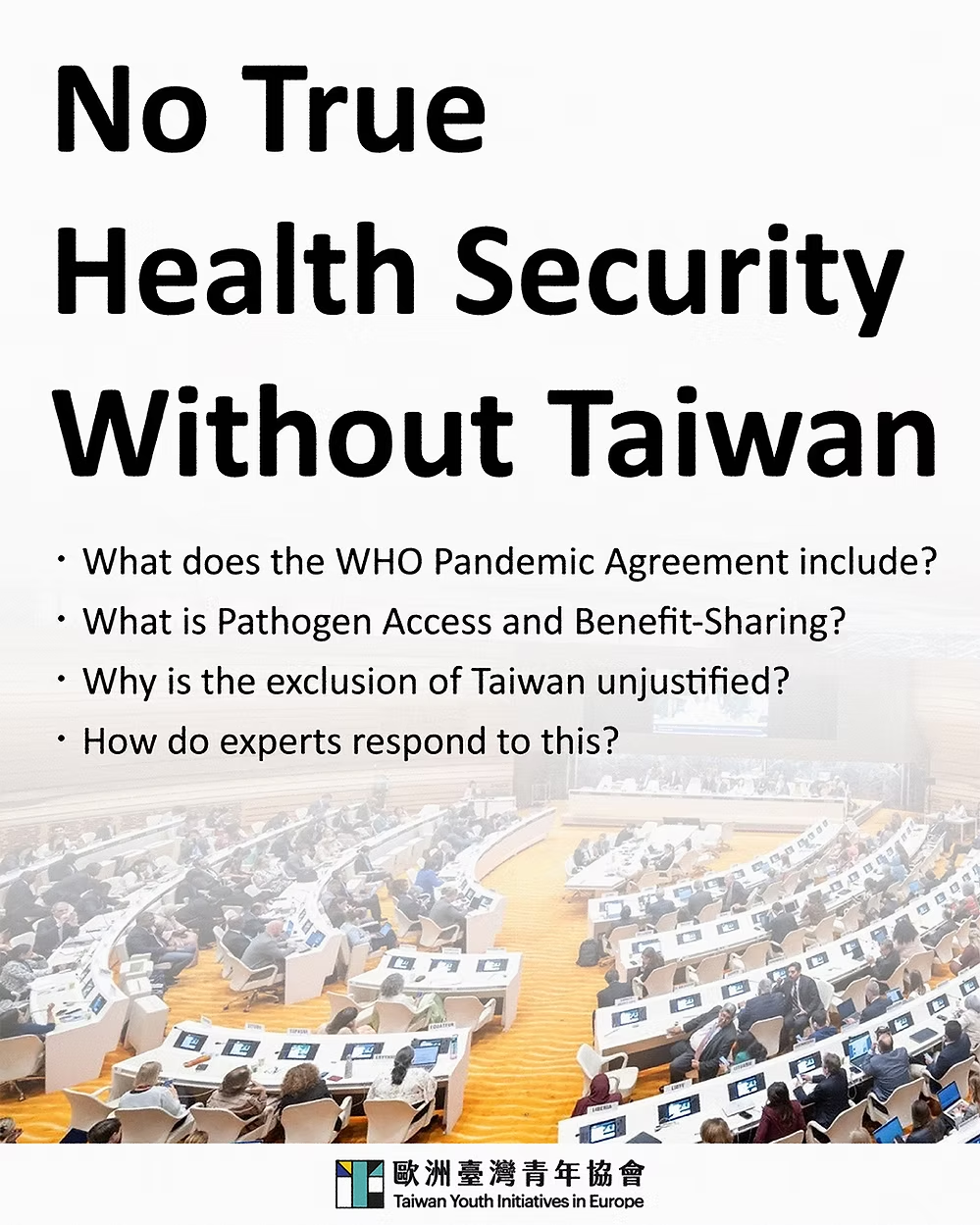I volunteer for the Taiwan Youth Initiatives in Europe (TYIE) and originally published this post on TYIE’s website, discussing :
- What is the WHO Pandemic Agreement?
- Why is the exclusion of Taiwan unjustified?
The approval of the World Health Organization (WHO) Pandemic Agreement by the 78th World Health Assembly (WHA) Committee in May marks a landmark global commitment to fortify pandemic prevention, preparedness and response (PPR) capacities. The agreement aims to achieve the common interest of a more equitable and better prepared world to prevent, respond to and recover from pandemics. It carries implications that transcend political boundaries, underscoring the urgency of inclusive participation for Taiwan.
 Infographic by: Rising Lai
Infographic by: Rising Lai
Inside the Pandemic Agreement
Emerging from the catastrophic lessons of COVID-19, the Pandemic Agreement establishes mechanisms to improve pathogen surveillance, promote equitable access to medical countermeasures, and enhance health system resilience.
A key provision is the Pathogen Access and Benefit-Sharing (PABS) system, whereby countries are obligated to share pathogen samples and related genetic information rapidly and equitably through the system. Pharmaceutical manufacturers accessing pathogen information commit to providing 20% of their vaccines, therapeutics, and diagnostics (10% as donations, 10% at affordable prices) to the WHO for distribution in emergencies.
The treaty also embraces a One Health approach, addressing animal-to-human transmission risks, and mandates combating misinformation while protecting health workers from stigma and violence.
COVID-19 revealed profound inequities and fragmentation in global health systems. A treaty fostering transparent data exchange, equitable resource allocation, and diversified regional manufacturing capacities can transform pandemic response from reactive crisis management to proactive resilience-building.
Tsung-Ling Lee, Professor at Taipei Medical University, told the Science Media Center Taiwan that the treaty is “a positive step toward preventing future pandemics—where the question is when, not if.”
Yet, critiques persist over its lack of enforcement mechanisms or concrete funding obligations, leaving effective implementation dependent on voluntary compliance and goodwill.
Over the next year, further negotiations will focus on drafting an annex to the treaty aimed at resolving outstanding questions such as PABS system.
Taiwan’s Contributions and Exclusion
Despite being denied WHA observer status for nine consecutive years, Taiwan continues to demonstrate its value as a trusted global health partner. During COVID-19, Taiwan was among the first to notify WHO of the emerging outbreak in Wuhan, leveraging its epidemic intelligence system to detect unusual pneumonia cases and formally raising inquiries as early as December 31, 2019.
Taiwan implemented effective border controls, and maintained a zero-COVID policy until 2022 – without lockdowns, recording the world’s ninth-lowest excess death rate from 2020-2022 according to The Economist. Taiwan scaled up mask production to become the second-largest global supplier, provided vaccines such as Medigen to countries like Australia and Thailand, and contributed rapid tests and traditional medicines to global diagnostic and treatment advancements.
The Pandemic Treaty permits participation only by UN member states, effectively preventing Taiwan from becoming a signatory. In Science Media Center Taiwan’s post, Po-Han Lee, Associate Professor, and Hsien-Ho Lin, Professor at National Taiwan University, Taiwan, warned that “without formal inclusion, jurisdictions like Taiwan risk being excluded from key data flows and benefit-sharing frameworks, despite their contributions to global health security.“
Lin Shih-chia, CEO of Taiwan’s Foundation of Medical Professionals Alliance, emphasized Taiwan’s vital role as a manufacturing and R&D hub for pandemic prevention in the Asia-Pacific. She urged that, if formal inclusion is not possible, Taiwan should attend as an observer and domestically implement the treaty as part of its “Taiwan can help” commitment.
A Call to Action
After three years of negotiations, the Pandemic Agreement offers hope for a safer and more equitable world. As WHO Director-General Dr. Tedros remarked, “In our divided world, nations can still work together to find common ground and a shared response to shared threats.” Yet the path forward remains uncertain. The US decision to withdraw from WHO and the unresolved PABS system annex cast doubt on its implementation.
Crucially, without inclusive participation, the treaty’s goals remain incomplete.
Taiwan’s exclusion is unjustified; it poses a global health risk.
Pathogens don’t respect borders, and any gap in surveillance or response endangers everyone. The international community must ensure Taiwan’s meaningful involvement - whether through observer status, parallel or bilateral agreements, or other collaborative frameworks.
| I thank Rising Lai for compiling the amazingly clear infographics featured in the article. I also thank the support of the TYIE friends. Views expressed here are my own and don’t represent the views of my employer, Taiwan Centers for Disease Control. |
